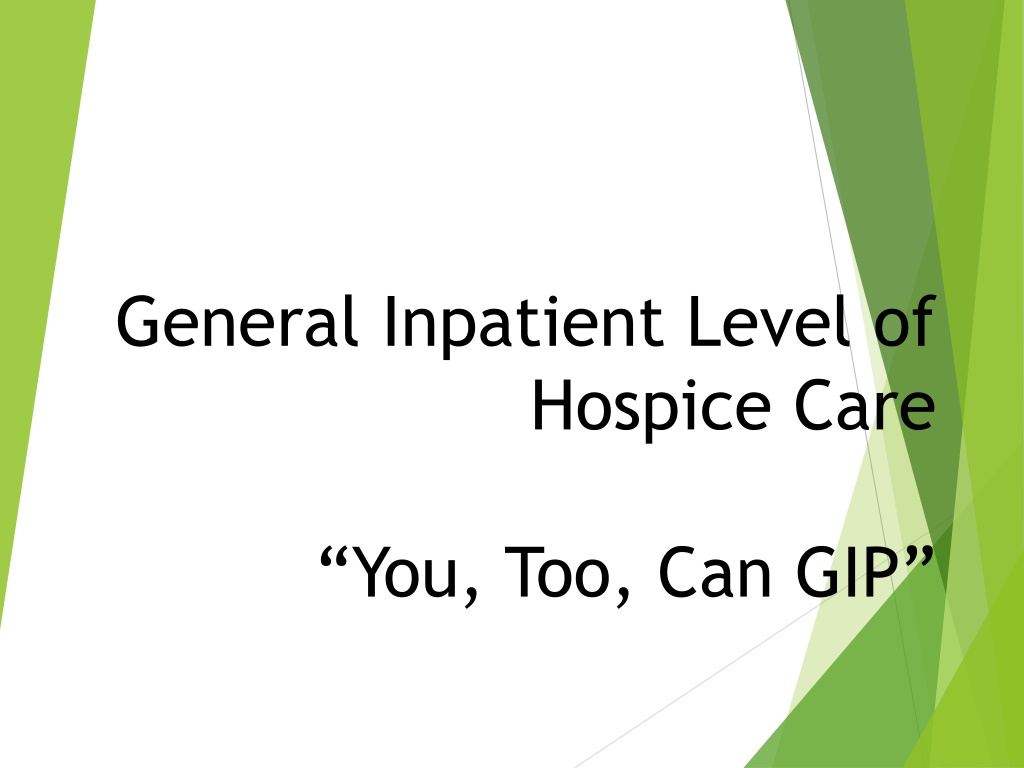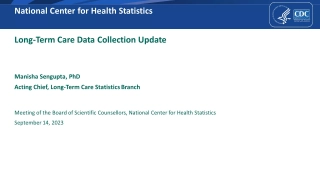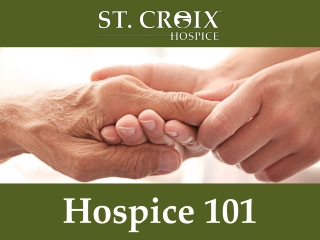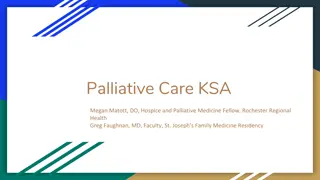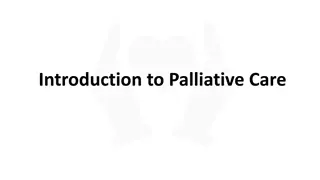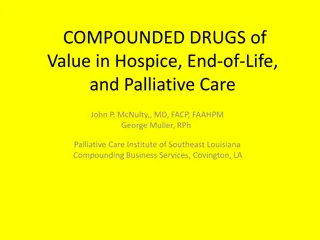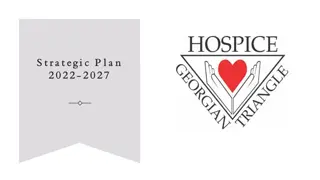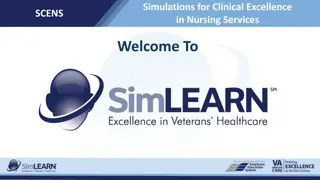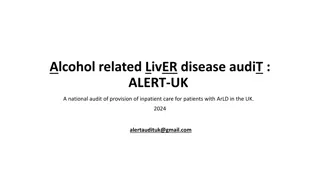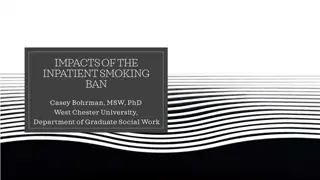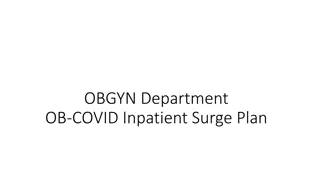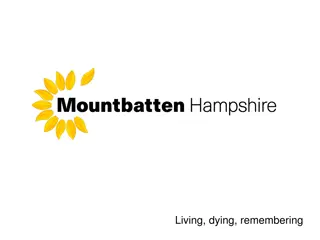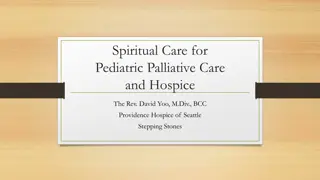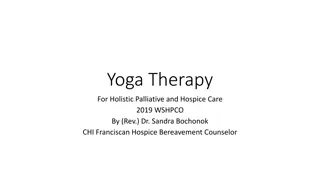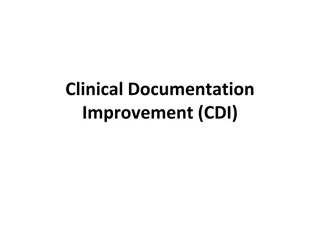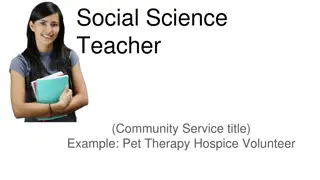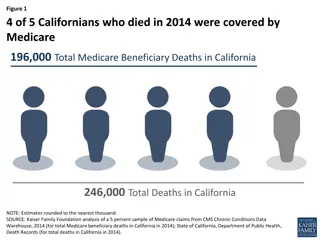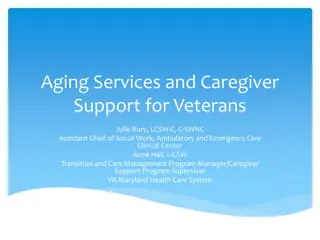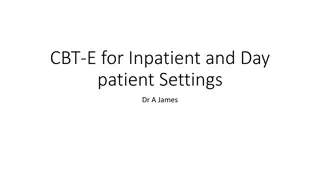Understanding Hospice General Inpatient Care (GIP)
Hospice General Inpatient Care (GIP) is a level of care in hospice settings intended for short-term management of acute symptoms that cannot be addressed in other settings. Initiated when other efforts for symptom management have not been successful, GIP provides skilled nursing care around the clock for patients needing intensive support to attain or maintain comfort. Eligibility for GIP is often associated with uncontrolled pain, deterioration requiring frequent evaluations, complex medical conditions, and other challenging symptoms. This level of care aims to provide comprehensive support for patients in their final stages of life.
Download Presentation

Please find below an Image/Link to download the presentation.
The content on the website is provided AS IS for your information and personal use only. It may not be sold, licensed, or shared on other websites without obtaining consent from the author. Download presentation by click this link. If you encounter any issues during the download, it is possible that the publisher has removed the file from their server.
E N D
Presentation Transcript
General Inpatient Level of Hospice Care You, Too, Can GIP
We need to trust that our patients are the experts on their lives, culture, and experiences, and if we ask with respect and genuine desire to learn from them, they will tell us how to care for them. Lipson, J. (1996)
Introduction Lori Kenyon, RN, BSN and Mary Gallien MSW with panel guests Hospice Physician, Dr. Arun Vijay and Clinical Manager, Krista Wassermann, RN, MSN
What is Hospice General Inpatient Care? (GIP) One of the 4 levels of Federal Medicare regulations require a hospice to provide as a condition of Certification. GIP is intended as a short term intervention for management of acute symptoms that cannot be managed in another setting.
When is Hospice General Inpatient Care? (GIP) considered Initiated when other efforts for symptom management have not been successful. For patients who cannot comfortably remain in a residential setting. And who require skilled nursing care around the clock to attain/maintain comfort.
Patient Status That May Lead to GIP Eligibility Uncontrolled pain requiring Sudden deterioration frequent evaluation by requiring intensive physician/nurse nursing intervention Complicated technical Frequent delivery of medication medication requiring skilled nursing adjustment assessment
Wounds requiring complex and/or frequent skilled dressing changes Intractable GI symptoms, Uncontrolled nausea/vomiting Pathological Delirium, with behavioral issues fractures Unmanageable respiratory distress
Skilled care required for unstable medical conditions may include Management of Dehydration Rapid onset of ascites or fluid retention causing pain not manageable in other settings Recurrent Seizures Frequent Suctioning Imminent death ONLY if skilled nursing needs are present
Joe Carson Patient Joe C is a 70 year old male with advanced colon cancer; metastases with pulmonary and hepatic involvement. Joe was rushed to ER/ED due to radiating leg pain, chest pain, persistent cough with hemoptysis, blood in stool, incontinence unable to be managed in home. Family wants all care treatment options possible. Patient responding poorly to aggressive efforts, prognosis poor
Joe Carson - Unmanaged symptoms present - Ongoing decline - Pt safety concerns, family uncertain what to expect, shocked at rapid decline.
What is not covered under GIP Care giver breakdown For care that can be provided in another setting Imminent death WITHOUT a need for aggressive symptom management
Betty Thompson current Hospice patient just arrived in Emergency Room Betty Thompson is an 82 year-old woman who lives in private home with twin sister Barbara and many cats. She was recently admitted to hospice with hospice diagnosis of dementia, chronic Hep C requiring increased level of care needs. Sister Barbara called 911 due to Betty s increased weakness, refusal to take medications and not allowing assistance with care. Barbara is wheel chair bound and has trouble providing hands on care. Barbara was met in ED by hospice RN to be evaluated for GIP admit and does not meet criteria. Betty was stabilized, given appropriate medications, IV fluids and sent home with alert to Hospice Care Team to f/u on possible placement.
How is GIP different from Routine Hospice Care? GIP Crisis stabilization in a Medicare certified Hospital, Skilled Nursing Facility, or inpatient hospice unit Routine Standard level of hospice care provided in patients place of residence -- home, long term care facility, assisted living setting, or adult family home
GIP Referrals from hospital may include: Hospitalized patient with deteriorating health status and unmanaged symptoms Pt is no longer a candidate for further treatment, but presents with skilled needs for symptom management Pt may have had an event (stroke, HA, seizures, embolism, etc..) that has precipitated acute symptom management needs
Referral To Inpatient Hospice GIP not met If Hospice Criteria is met but GIP Criteria is not met, then admission to Hospice can be scheduled for the day patient discharges from hospital to home or skilled facility.
Hospice Consults & Admitting Criteria
Already in the bed -------------------- Hospital in-patient to Hospice GIP status. Referral comes from attending physician, requesting evaluation for GIP status. Hospice responds with GIP evaluation. . . Hospice admit nurse coordinates admit visit with family. Once admitted, patient, family, physician, and Hospice Care Team initiate plan of care.
Hospice Community patient admitting to GIP in hospital setting. Pt determined to have intractable symptoms unmanaged in the home setting. Hospice may arrange transport as needed, POLST to accompany patient. Hospice Triage or Care Team RN, contacts hospital ER/ED Physician
Hospice Community patient admitted to GIP in hospital setting. Preliminary measures toward comfort are addressed in the ER, and fully assessed by a Hospice RN, preferably Care Team RN. Determination made that GIP criteria is met by Hospice RN. Then patient is admitted to hospital through ED/ER.
Getting into the GIP Bed Community Patients to GIP Confirm Insurance coverage for inpatient care Confirm Hospice Contract with hospital of choice Notify patient s Attending Physician for Hospice Notify Hospice Clinical Manager and Administrator On-Call (AOC)
Getting into the GIP Bed At the Hospital .. Confirm Attending Physician in agreement to admit patient to GIP level of care. Confirm patient s hospice diagnosis is related to the hospital admitting diagnosis. Hospice diagnosis must appear among the first 3 admitting diagnosis Care coordination with MD, hospital staff and family to determine to plan for symptom management.
Getting into the GIP Bed At the Hospital .cont. Questions to Consider: What is the most appropriate symptom management to return patient to previous level of care? Is this symptom management consistent with patient s previous and current Plan of Care and Goals?
AT THE HOSPITAL The most important non-clinical notification Financial Responsibility Notify the admissions/billing department of decision to admit patient. GIP and forward any need forms to confirm financial responsibility to billing office. Clarity around financial responsibility is critical to a smooth admit and transition to GIP in a hospital or a Skilled Nursing Facility setting.
Hospice Team for General Inpatient Care
Hospice Team - GIP Experienced Hospice Clinicians Hospice Physicians End of Life teaching/education to staff, patient, and family members. Maintains family goals toward developing Plan of Care
Hospice Team - GIP Symptom management, emotional and spiritual support Comfort care protocols in an acute environment. Discharge planning discussion with patient/family initiated upon admission. Hospice ensures that families can get formal hospice bereavement services for 13 months after the event of the patient s death.
Guidelines for Attending Physician Orders for hospice inpatient stay written by Attending Physician Comfort Care order set initiated in EMR by physician/hospitalist Routine follow up by Attending Physician during hospice admission
Guidelines for Attending Physician Signs Hospice Plan of Care Daily contact with hospice team Hospice team member(s) will visit patient daily Hospice Medical Director/Hospice physician will be available as a resource
Hospice Physician Provides onsite hospital consultations for; Goals of care, Disposition recommendations, Care Coordination and Symptom Management PR/Consults for hospice as well as liaison for hospice. Coordinates with hospice pharmacists, Care Team and staff around symptom management challenges.
Care Team Management/Support Initial Encounter Enter room together as a team when possible Ask what family and patient understands about disease process and prognosis? Explain how addition of hospice care team to Hospital team can benefit patient to provide best care. Main Concerns Goals of care Patient assessment
Registered Nurse GIP role Assessment GIP: Head to toe assessment with focus on; Psycho/social how is patient participating in conversation interaction with RN, what are they saying, how they are saying it. Assess Pain levels, SOB, unmanaged symptom concerns and changes since hospitalized. What has worked/not worked. Request to further assess, Nero, CV RRR, Lungs CTAB, work of breathing, discomfort, signs and symptoms of anxiety, agitation determine baseline and goals Is our patient eating, bowel care, mobility and independence, desire for help/support, skin integrity Active needs: increased suctioning, bolus dosing of medication, etc.. REVIEW WHAT I AM SEEING WITH FAMILY/THOSE PRESENT IF APPROPTIATE. Discuss review, what is changing.
Registered Nurse GIP role Charting Clinical Note, EMR Note GIP Day 1, Day 2, Day 3 etc. Supportive Data that the symptoms are ongoing: Pt continues to meet GIP eligibility for state the uncontrolled symptom(s) Ongoing Issues: Patient response to current interventions; if any Measureable outcome: pain ratings and quotes from patient family Providing recommendations to manage symptoms and education provided to staff and family. Discharge plan: TBD Coordinated care with: i.e.... Name Care Givers involved in development of POC for comfort. Please contact your Hospice Agency for symptom management needs, changes in condition, or at time of death
MSW/GIP: Assessment, Documentation, and Beyond Precipitating Event prior to GIP status Location/ Who is Present at this Visit Initial MSW Assessment or SW Assessment Ideally the Initial Assessment includes the RN and MSW in joint visit
MSW-GIP Assessment Documentation, and Beyond Social Hx/Support Network Neuro/Emotional/Behavioral Status Communication Capacity/Ability Code Status(if in question or not completed)
MSW---GIP Assessment, Documentation, and Beyond Funeral Home Financial Concern/Insurance Resource/Counseling Provision emotional adjustment counseling reflective inquiry with patient and/or family members Written information given to go over in a quiet moment at the bedside
MSW---GIP Assessment, Documentation, and Beyond Care Coordination Disposition Discharge to home setting Discharge to SNF or AFH, Timing of Discharge Placement efforts
MSW---GIP Assessment, Documentation, and Beyond Should patient die in hospital setting reassure family of care taken with transition to mortuary care Check with hospital staff to see if there is a limit on time spent with patient after death Help family understand the role of the Funeral Home for post-death tasks Grief Support accessibility and follow up
Challenges Family does not want patient to leave hospital no matter what Family unavailable Placement challenges, lingering, high acuity of medication delivery, vent Families not willing to try different medications easily given in other environments. Discharge back to hospital
Chaplain GIP role: supports patient, family, hospital staff, and Providence care team throughout GIP hospitalization. Assesses and identifies religious/spiritual goals, challenges, and strengths Provides supportive spiritual and emotional presence Facilitates sacramental rites, faith community visits as requested
Chaplain GIP role: supports patient, family, hospital staff, and Providence care team throughout GIP hospitalization. Coordinates with hospital chaplain on handoff of spiritual plan of care to hospice chaplain Provides increased availability and prioritization of GIP patients as needed Ensures discharge handoff of spiritual plan of care to hospice community team chaplain
Patient ready for discharge Home Obtain orders for change to hospice routine level of care Update community attending physician responsible for medication orders after discharge. Durable medical equipment; OT referral for safety
Patient ready for discharge Home Coordinate with infusion as needed, have hospital physician write orders for medications x1 week. Provide needed education to a willing family member on; care of drains, medication administration, basic care as needed. Provide Tuck-in visit
Patient ready for discharge Skilled Facility (SNF) Obtain orders for change to hospice routine level of care Update community attending physician responsible for medication orders after discharge. Durable medical equipment; OT referral for safety
Patient ready for discharge Skilled Facility (SNF) Coordinate with infusion as needed, have hospital physician write orders for medications x1 week. Provide REPORT to SN around patient care needs, Goals of Care, DPOA, patient and family challenges. Routine that has been effective. Patient likes dislikes if known. Provide Tuck-in visit, check in with facility RN
Paint the Picture (The picture you paint is the picture Medicare will use to determine whether this level of care is appropriate and reimbursable). Pt with end stage pancreatic caner continues to meet GIP criteria for pain poorly managed at home. Unable to take PO medications due to nausea/vomiting. Requires frequent nursing interventions and assessment to ensure comfort. Pain was 9/10 when arrived to HCC, now reports improved at 6/10 with ongoing titration of dilauded infusion and Q4H doses of SQ Haldol effective patient. denies nausea at this time.
References National Hospice and Palliative Care Organization, A Clinical Guide to Hospice General Inpatient Care (GIP) (2018) Documenting to support General Inpatient (GIP) Hospice Level of Care. (2018) https://nhpco.org/sites/default/files/public/regulatory/GI P_Tip_GIP_Sheet.pdf Check-Lists: Admit, Discharge, Transfer
